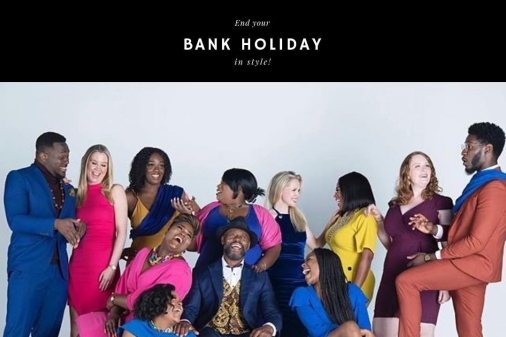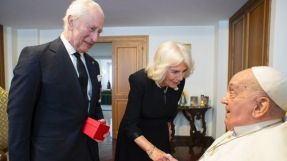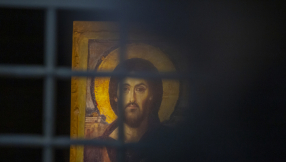
There are about 4,000 Black Majority Churches in Britain today with over 300,000 members. It's a term I wouldn't say I like, for it's far too sociological; it's an artificial construct, devoid of any theology, and limits any understanding of it. Black Pentecostal is a much better term for it describes this church community more adequately.
The general assumption in Britain is that Black Pentecostals are a homogenous group. But nothing can be further from the truth. They are a diverse community, made up of independents, established denominations, 'Oneness' Pentecostals (Jesus Only), Trinitarians, Apostolic and Sabbatarians, and although they all have many things in common, they also differ significantly.
In the 1950s and 60s, when Caribbean Pentecostals first came to Britain, it didn't take long for them to establish their churches. They met in 'prayer meetings', in each other's homes, and from there, moved to rented halls before buying their churches.
The Church of God in Christ (1953) is Britain's oldest Black Caribbean Pentecostal Church, and it led the way for others to follow. They included the New Testament Church of God, the Church of God of Prophecy, Bethel United Church of Jesus Christ (Apostolic), the New Testament Assembly, and the International Church of the Firstborn, formally known as the Church of God.
Music was central to these newly arrived Christians, and in their services they hardly had any instruments to accompany their singing, perhaps only a tambourine. But that didn't stop them holding their services, and as more and more of them came, they could at least boast a guitarist or a person who played the piano. With this, they could now clap their hands as they worshipped, stomp their feet, sway their bodies, and shout hallelujah, both as a reminder of the 'hot times' in church back home, and a sign of how they wished to serve God in the new country.
Most of the musicians who came couldn't read a music score and because of this, played 'by ear' or how they heard the music. It meant that if a musician was visiting a church and wanted to play their instrument in the service, all they had to do was set themselves up alongside the existing musicians and join in and play. At first, this ad hoc arrangement and the range of musical abilities worked reasonably well, as most players could be relied on to keep a steady beat, but at times the music left a lot to be desired.
Hymns and choruses dominated the singing, which is a throwback to the time when the Anglican and American churches had enormous influence in the region. Hymns came with the hymnbook, "Hymns Ancient and Modern," introduced in Jamaica in 1861, and choruses came later when American missionaries arrived in Jamaica.
Singing to a beat is standard practice in Caribbean churches, and whether it is singing a hymn, a chorus, or a song, it's done to a beat. Until recently, Caribbeans 'tracked' their hymns, which is when a congregation member reads aloud, line by line, the words of a hymn as it's being sung, and with this, the congregation joins in, singing each line simultaneously until the hymn is finished.
The idea of 'tracking a hymn' is thought to have originated in Scotland, taken to the Southern States of America where it's called 'lining,' and in the 1780s found its way into Jamaica. Today this type of singing no longer exists but it was once a familiar way of singing in Caribbean churches.
Apart from hymns, Caribbeans sang choruses all the time in their services, and although they are rarely heard today, they were once the distinct identity and expression of Caribbean Church music. They are a mixture of Jamaican folk and Southern gospel songs, and when a congregation unites in singing them, the late Joel Edwards described it as incorporating a "bold simplicity and urgency, conveyed by repetitive and uncompromising directness".
In the "Fire Next Time", James Baldwin likens them to, "the saints rejoicing, the sinner moaning, the tambourines racing, and all those voices coming together and crying holy unto the Lord."
Choruses came out of the 'Great Revival' tradition in America, when after a period of economic, social, and political failures, the country turned to God in a time of mass prayer meetings, repentance, and spiritual renewal.
In the 1850s, this sense of spiritual awareness reached Jamaica and there the songs and religious expression of the 'Great Revival' fused with indigenous Jamaican music and African beliefs. Out of this, the Jamaican Revivalist tradition was born, with singing, swaying, drumming, dancing, and feet stomping. Jamaican Pentecostals took many of these to Britain, and for many years, they were a feature of Caribbean worship.
For over seventy years Caribbean Christians have been a quiet witness in Britain. Until recently, what most people knew of them is what they saw each Sunday - groups of Caribbeans Christians making their way to church with their families following after them. In all fairness, that's about all they knew, and it wasn't surprising, as Caribbean Christians tended to keep themselves to themselves, away from mainstream society, preferring to grow their churches and their families.
The big change came in 1969 when Edwin Hawkins, the American gospel singer, produced a reworking of an old 18th-century Baptist hymn, "Oh Happy Day that Fixed my Choice". Every Caribbean Christian knew the song as they sang it regularly in their churches. What Hawkins did was to rework this old hymn, write a new arrangement to it, give it a modern beat, and in the process, create a phenomenon.
In 1969, Hawkins released "Oh, Happy Day" and it became the biggest gospel hit. It reached number 4 in the American pop charts, number 2 in the UK, and Number 1 in France and Germany. It sold over seven million copies, and as the song was out of copyright, Hawkins claimed all the revenue from it.
For over twenty years, this interest in gospel music continued in Britain, and in the 1980s, record companies were so convinced that the next big music would be gospel that they went out into the Caribbean Community to see if they could find a gospel choir to replicate what Hawkins had done earlier. They found the London Community Gospel Choir and The Inspirational Choir and signed them both.
Throughout the 1980s, this interest in gospel continued, and the music was regularly heard on the radio in Britain, on television, in concerts, colleges, universities, and at major pop festivals including Glastonbury!
Even in the pop music of the day, you could hear the influence in the songs of James Brown, Aretha Franklin, Stevie Wonder, The Supremes, The Temptations, Marvin Gaye, Smokey Robinson, The Staple Singers and virtually every Tamla Motown artist who dominated the airways. What's more, whenever these artists did an interview, they'd always mention their church and gospel upbringing, merely adding to the growing interest of the music in Britain.
Gospel was also in the West End too. It was in "Amen Corner", the James Baldwin play, in "King" the musical based on the life of the great man, and in "Mama, I want to sing", the musical that charted the life of Doris Troy ("Just one Look") from a Pentecostal home to Broadway.
The BBC also got in on the act, and in 1982, broadcast its first gospel "Songs of Praise" programme from Southwark Cathedral. It featured Sam King, who in 1948 arrived on the Empire Windrush and who by 1982 was the Mayor of Southwark - its first Black mayor. Channel 4 followed and commissioned, "People Get Ready", the first-ever gospel music series on British television.
Despite all this growing interest in gospel music, Caribbean church leaders were initially reluctant to accept and embrace it, as it smacked too much of secular or 'worldly music'. What brought about the change was the young people who supported it, the weight of the record companies behind it, and the success of the music in America, where it was becoming big.
While all this was happening, white Christians, especially those from the evangelical tradition, noted what was happening. They described Caribbean services as vibrant worship and were slowly influenced by it. The popularity of gospel music also inspired them, as did the spontaneity of Caribbean worship.
Soon they were modernising their services, and one of the first things they did was to throw out the pews in their churches, freeing up space for a more relaxed and informal attitude to worship. Also, they began to change their music, and rather than rely on the organ, they introduced modern instruments, including acoustic guitars, flutes and the piano, pioneering a new soft, folk rock Christian sound.
White Christian groups upped their game also, especially in the area of their performances and in the commercial development of their music. 'Word' and 'Kingsway Music' got behind Evangelical artists, and people like Graham Kendrick came to the fore.
What gospel music has done for Caribbean Pentecostal churches is that it has given them a profile that belies their size and influence. It's far easier to get a Black gospel choir on television, than a white Christian group or artist. It's easier to get a glimpse into this church community in documentaries and profiles, for the web of its influence and the extent of its reach stretches far and wide.
Even in the pop world, many of the musicians and backing vocals behind the biggest names in the business are from the gospel community and first cut their teeth in the London Community and the Inspirational gospel choirs.
Gospel music in Britain is evolving, and the music is going through another change, as African artists are now bringing their gifts and talent to the music.
Roy Francis is an award-winning former BBC 'Songs of Praise' producer and the author of 'Windrush and the Black Pentecostal Church in Britain'.













